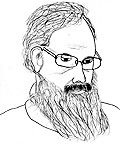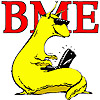
|
| SoE home |

|
| Kevin Karplus's home page |

|
| Biomolecular Engineering Department |
(Last Update: 2017 June 5 15:10 PDT )
BME 51B is open to anyone who has passed BME 51A, but should be taken immediately afterwards, as the division of the material between the two parts may change from year to year.
The theme for the course is "connecting real-world signals to computers using analog electronics". The second part, BME 51B, will concentrate mainly on characterizing sensors and transducers (including non-linear models) and on amplifier design. We will work with microphones, loudspeakers, and electrodes this quarter.
Most of the basic concepts were covered in BME 51A—this quarter will concentrate on applying those concepts and gaining facility in using them for design. New concepts include inductors and pulse-width modulation. We will also revisit band-pass filtering.
This quarter uses the tools and parts acquired in BME 51A, plus a few new parts. The new parts will be provided in the first lab meeting, as we will be using them immediately. Dropping the course does not result in a refund of lab fees if you have already gotten the parts.
We will continue to use PteroDAQ, available free from
http://bitbucket.org/abe_k/PteroDAQ/downloads
under the "Tags" tab. Select the "default" branch under the
"branches" tab and download in zip, gz, or bzip2 archive format.
A version is installed on the lab machines
at C:\ProgramFiles\PteroDAQ, but you are much better
off using your own laptops.
Documentation is downloaded with the source, but only the
installation is reasonably documented right now.
You'll need Python installed: I recommend the Anaconda distribution,
as it loads useful modules, like NumPy and SciPy.
We'll continue doing plotting and model-fitting examples with gnuplot. Gnuplot can be downloaded from the http://www.gnuplot.info/ website, but installation on Macs is sometimes tricky. See the post, which has updated instructions at the end of the post.
Some software is provided on the class website:To offset the high parts cost, we'll be using only free on-line material for the textbook.
I have been writing this book specifically for this class, and it is not quite done. I don't expect any updates during the quarter, but I will frequently solicit suggestions for additions or improvements needed. Students will be able to download any future editions that I distribute through LeanPub for free—the LeanPub model is designed for work-in-progress books.
In the early years (before my book draft), students found this the most useful of the on-line sources, as the tutorials assume no prior knowledge.
The author of All About Circuits has also made a number of video lectures and practice worksheets available. Not all the worksheets are relevant to this course, but it should be fairly evident which are and which aren't. I may assign some of these, but you are encouraged to try them on your own whether or not they are assigned.
In previous years, many students found the Wikipedia articles too difficult for them, though they are often a better reference than All About Circuits, allowing you to go deeper into the material.
The labs are contained in the textbook, rather than as separate lab handouts. The entire book is is required reading for BME 51A+B—the chapters provide essential understanding for the design work in the labs, and homework will be preparation for the labs. Students who do not attempt the homework ahead of time are doing their lab partners a major disservice and take up too much of the group tutor and instructor time in the lab, hurting everyone else in the section.
It is essential to read the lab chapters and do the design work before coming to lab—this is a design class, not lab-demo class, so most of the writing and thinking has to happen before the lab time. Students in past years who did not have completed designs before lab generally wasted a lot of lab time doing pencil-and-paper work and had trouble getting their designs built and tested.
Each lab will be done with a different partner (and occasional singletons). There should be no repeat pairings, including the pairings from BME 51A. Pre-lab work should be done separately, but post-lab work can be done together or separately. A detailed design report will be required for each lab.
Change this quarter:All design reports will be required to be done using LaTeX—documents produced with Word will not be accepted. There will be some instruction in LaTeX and BibTeX. A number of students have found the sharelatex site https://www.sharelatex.com/ to be useful for collaboration on documents—it is free for two people working together.
| Date | Lab |
|---|---|
| Tues 4 Apr 2017 | Lab 7: microphones |
| Thurs 6 Apr 2017 | Lab 7: microphones |
| Tues 11 Apr 2017 | Lab 8: loudspeakers |
| Thurs 13 Apr 2017 | Lab 8: loudspeakers |
| Tues 16 Apr 2017 | Lab 9: audio preamp |
| Thurs 18 Apr 2017 | Lab 9: audio preamp |
| Tues 25 Apr 2017 | Lab 9: audio preamp (soldering) |
| Thurs 27 Apr 2017 | Lab 9: audio preamp (soldering) |
| Tues 2 May 2017 | Lab 9: audio preamp (soldering) |
| Thurs 4 May 2017 | Lab 10: class-D power amp |
| Tues 9 May 2017 | Lab 10: class-D power amp |
| Thurs 11 May 2017 | Lab 10: class-D power amp |
| Tues 16 May 2017 | Lab 10: class-D power amp |
| Thurs 18 May 2017 | Lab 11: electrodes (stainless steel) |
| Tues 23 May 2017 | Lab 11: electrodes (Ag/AgCl) |
| Thurs 25 May 2017 | Lab 11: electrodes (Ag/AgCl) |
| Tues 30 May 2017 | Lab 12: EKG |
| Thurs 1 June 2017 | Lab 12: EKG |
| Tues 6 June 2017 | Lab 12: EKG (soldering) |
| Thurs 8 June 2017 | Lab 12: EKG (soldering) |
Anyone caught cheating in the class will be reported to their college provost (see UCSC policy on academic integrity for undergrads and for grad students), will fail the assignment, and may fail the class. Cheating includes any attempt to claim someone else's work as your own. Plagiarism in any form (including close paraphrasing) will be considered cheating. Use of any source without proper citation will be considered cheating. If you are not certain about citation standards, please ask, as I hate having to fail students because they were improperly taught how to cite sources.
Collaboration without explicit written acknowledgment will be considered cheating. Collaboration on lab assignments is expected, even required—but that doesn't remove the requirement to acknowledge the collaboration.
Design reports are expected to be entirely the work of the two partners on the project. Copying block diagrams, schematics, or other elements of the report is not acceptable, even if acknowledged.
UC Santa Cruz is committed to creating an academic environment that supports its diverse student body. If you are a student with a disability who requires accommodations to achieve equal access in this course, please submit your “Accommodation Authorization Letter” from the Disability Resource Center (DRC) to Prof. Karplus privately during office hours or by appointment, as soon as possible in the academic quarter, preferably within 1 week. I also am open to and want to encourage you to discuss with me ways we can ensure your full participation in this course. If you have not already done so, I encourage you to learn more about the many services offered by the DRC. You can visit their website (http://drc.ucsc.edu/index.html), make an appointment, and meet in-person with a DRC staff member. You can also reach them by phone +1-831-459-2089, 459-4806 (TTY), or email drc@ucsc.edu
Students will be graded primarily on the five design reports, due weekly. The pre-lab homework combined will be worth about one design report. Homework will not be accepted late and cannot be redone for credit.
In addition there may be one or two quizzes, each with weight equal to one of the design reports. The need for quizzes will be determined mainly by how diligent students are about doing the pre-lab design work.
Lab reports that get a grade of C+ or lower can be redone once, with a new due date a week after the reports are returned to the class. (Being absent when reports are returned does not extend the due date.) Those with a grade of "REDO" must be redone, or they will be converted to "F". Grading standards are somewhat higher for redone reports, so that minor errors that would have been tolerated in a first draft will be judged more harshly in a redone report. All previously graded versions of the report must be turned in with any redone report.
| Due | Read | Turn in |
|---|---|---|
| Mon Apr 3 | Chapters 20, 21(=Lab 7) | |
| Wed Apr 5 | redo Exercises 20.1–20.5, 21.1–21.5 | |
| Fri Apr 7 | Chapters 22, 23, 24(=Lab 8) | |
| Mon Apr 10 | Exercises 23.1–23.3, 24.1–24.3 | |
| Wed Apr 12 | Chapter 25 (=Lab 9) | |
| Fri Apr 14 | Exercises 25.1–10 | |
| Mon Apr 17 | Sections 10.5, 14.2.5 | |
| Wed Apr 19 | Sections 26.1–26.6 | Exercises 10.4, 10.5, 14.5, 14.6 |
| Fri Apr 21 | Lab 7+8 report | |
| Mon Apr 24 | Sections 26.7–26.11 | Exercises 26.1–26.4 |
| Wed Apr 26 | Chapter 27(=Lab 10) | |
| Fri Apr 28 | Exercises 27.1–27.4, 27.7–27.9 | |
| Mon May 1 | ||
| Wed May 3 | Chapters 28, 29(=Lab 11) | Exercises 27.5–27.6, redone Lab 7+8 reports |
| Fri May 5 | Lab 9 report | |
| Mon May 8 | ||
| Wed May 10 | ||
| Fri May 12 | Exercises 28.1–3, 29.1–29.3 | |
| Mon May 15 | ||
| Wed May 17 | Chapters 30, 31, 32(=Lab 12) | In-class quiz |
| Fri May 19 | Lab 10 report | |
| Mon May 22 | ||
| Wed May 24 | ||
| Fri May 26 | Exercises 32.1–32.5 | |
| Mon May 29 | Memorial Day, no class | |
| Wed May 31 | Exercises 32.6, 32.7, Redone reports for Lab 10 | |
| Fri Jun 2 | Lab 11 report | |
| Mon Jun 5 | ||
| Wed June 7 | ||
| Fri June 9 | instructor absent, no class | |
| Thurs Jun 15 | Putative exam time 4 p.m.–7 p.m., probably not used. | Lab 12 report, redone Lab 11 report: 4 p.m. |
|
|
| BME51 home page |
Questions about page content should be directed to
Kevin Karplus
Biomolecular Engineering
University of California, Santa Cruz
Santa Cruz, CA 95064
USA
karplus@soe.ucsc.edu
1-831-459-4250
318 Physical Sciences Building